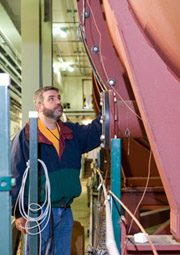Tom Kobilarcik:
a man of many hats
 |
| Tom Kobilarcik works on the beamline for the E-905 / SeaQuest experiment |
If you ask Tom Kobilarcik to explain his job, you won’t get a short answer.
“It’s hard to explain a typical day; there aren’t typical days,” said Kobilarcik, an engineering physicist for the External Beamlines Department. “But it doesn’t get boring, and that’s what I like about it the most.”
Kobilarcik, who has worked at Fermilab since 1989, began as a beamline operator before moving into a coordination role for beamline installation. In the past year, Kobilarcik was promoted to External Beamlines Department deputy head. In his new role, he will direct numerous support teams to install all the projects that use particle beams.
Kobilarcik currently oversees the installation and machine maintenance of four beamline projects: MiniBooNE, the MuCool Test Area, the E906 SeaQuest project and the NuMI target station. Planning these endeavours can take anywhere from months, in the case of E906, to decades, in the case of the NOvA neutrino experiment.
“The type of thing where you have to put together a lot of pieces and make sure it all works in a very precise way, that’s the type of thing that Tom is genuinely very good at,” said beamline physicist Sam Childress, who has worked with Kobilarcik for 21 years.
The job’s challenge, Kobilarcik said, is determining the best way to use Fermilab’s abundant talent to get a project running most efficiently.
“Once you’ve done that, you step back and let the other groups do their job and the project gets done really well,” Kobilarcik said.
Often, beamline projects are technically challenging. The difficulties arise in instances such as designing a magnet for the KTeV kaon experiment, which required a large team of skilled physicists. Others require a diversity of skills. In one such project, Kobilarcik had to couple his computer programming abilities with his beamline knowledge to develop high-precision software to steer a particle beam.
Kobilarcik credits the various support groups – engineering, mechanical support and instrumentation among others – for the success of his projects.
“We’ve got great people working here,” he said. “Our technicians and our professional staff really put the sweat into it to get the projects going.”
-- Sara Reardon
|